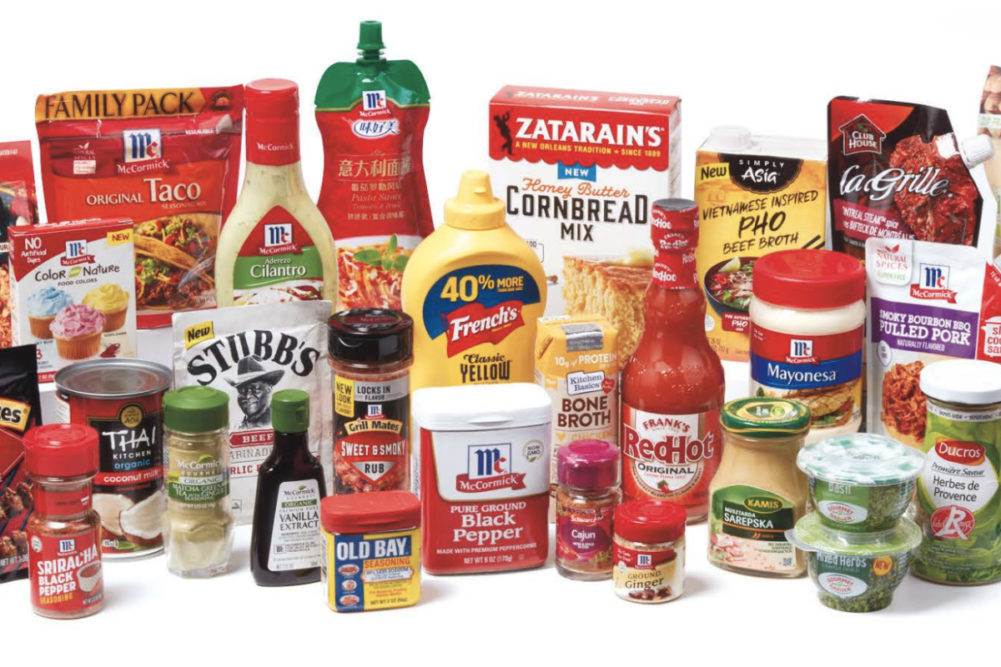HUNT VALLEY, MD. – In December, McCormick & Co.’s consumer production output, those products intended for sale at retail, was approximately 40% higher than the year prior. It was a good problem to have, but one that constrained the company’s supply chain and impacted the production of products deemed secondary, non-core items.
“Currently, service levels are improving and restoration plans have begun on most of the secondary items, which were suspended in order to meet the significant demand for our top-selling products,” said Lawrence E. Kurzius, chairman, president and chief executive officer of McCormick & Co., during a Jan. 28 conference call to discuss fiscal 2020 results. “We’ve now resumed shipping approximately two-thirds of the products, which had been suspended, with the balance to be added over the next several weeks. And we expect shelf conditions to improve considerably over the next few weeks.”
Mr. Kurzius emphasized the issue is strictly an Americas problem and has to do with the scale of McCormick’s Consumer business in the region.
“Even in normal circumstances, we have to prebuild inventory to supply the huge demand that comes through in those categories in the fourth quarter of the year,” he said. “And coming into the fourth quarter, (it was) very much hand-to-mouth already due to the sustained demand.”
The elevated levels of demand had a positive effect on the company’s performance during the year. Net income for the year ended Nov. 30, 2020, was $747.4 million, equal to $2.80 per share on the common stock, and an increase when compared with fiscal 2019 when the company earned $702.7 million, or $2.65 per share.
Sales for the year rose to $5.6 billion compared with $5.35 billion in fiscal 2019.
“The sustained shift of consumer behavior to cooking and eating more at home or at-home consumption drove substantial increases in our Consumer segment demand as well as increases with our packaged food company customers in our Flavor Solutions segment,” Mr. Kurzius said. “On the other hand, we experienced declines in demand from our restaurant and other foodservice customers in the away-from-home products in our portfolio. The impact of this shift to more at-home consumption has varied by region due to differing levels of away-from-home consumption as well as the pace of each region's COVID-19 recovery.”
Consumer business segment sales rose to $3.6 billion for the year, up from $3.3 billion the year prior. Operating income leapt to $781 million from $676 million in fiscal 2019. The company said the sales increase was driven by many brands, but particularly its Lawry's, Frank’s RedHot, French’s, Zatarain’s, Simply Asia, and Thai Kitchen lines.
Flavor Solutions segment sales were flat during the year at $2 billion when compared with the previous year. Operating income fell to $238 million from $302 million in 2019. The decline was driven by weak foodservice demand, unfavorable product mix, COVID-19 related costs and higher employee benefit expenses, according to the company.
In fiscal 2021, management, Michael R. Smith, chief financial officer, said he expects constant currency sales to increase 5% to 7%, including an incremental impact from the recent acquisitions of Cholula and Fona International of 3.5% to 4%.
He said adjusted earnings per share are expected to be in a range of 1% to 3% on a constant currency basis.
“Our guidance range for adjusted earnings per share in 2021 is $2.91 to $2.96, compared to $2.83 of adjusted earnings per share in 2020,” Mr. Smith said.
Mr. Kurzius added, “Our fundamentals, momentum and growth outlook are stronger than ever. Our 2021 outlook reflects another year of differentiated growth and performance while also making investments for the future. We are confident we will emerge stronger from these uncertain times.”






